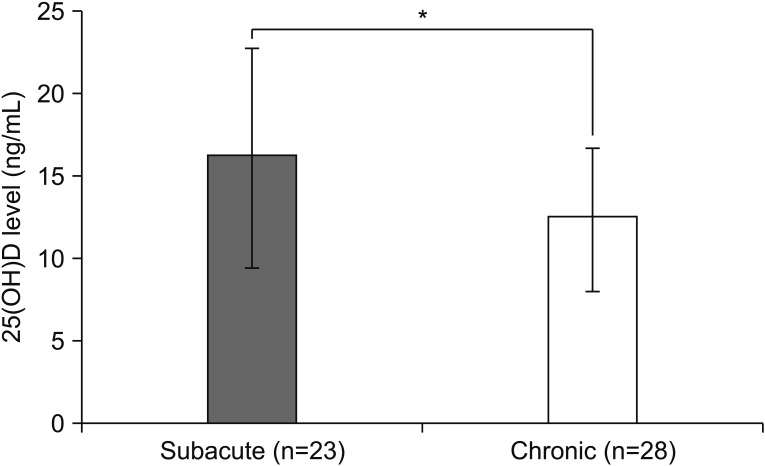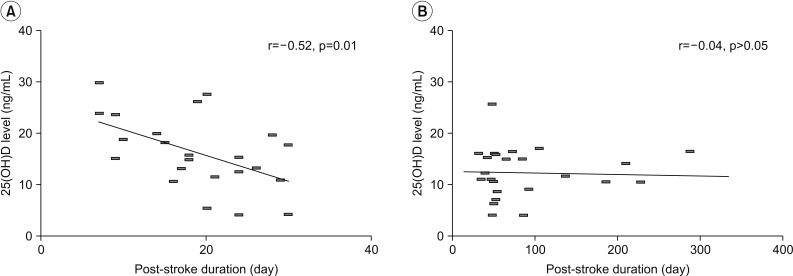Ann Rehabil Med.
2017 Dec;41(6):944-950. 10.5535/arm.2017.41.6.944.
Decrement of Serum Vitamin D Level After Stroke
- Affiliations
-
- 1Department of Rehabilitation Medicine, CHA Bundang Medical Center, CHA University, Seongnam, Korea. kmin@cha.ac.kr
- KMID: 2400278
- DOI: http://doi.org/10.5535/arm.2017.41.6.944
Abstract
OBJECTIVE
To investigate the serum vitamin D level and its determinant factors in stroke patients.
METHODS
Fifty-one stroke patients who had documented serum level of 25-hydroxyvitamin D(25(OH)D) were included. Patients were divided into subacute (n=23) and chronic groups (n=28). The mean levels of 25(OH)D of the two groups were compared. Correlations between each 25(OH)D level and post-stroke duration were also analyzed. To assess other possible influencing factors, patients were subdivided by ambulation ability and feeding methods for comparison of 25(OH)D level.
RESULTS
The mean level of 25(OH)D was significantly lower in the chronic group than in the subacute group (12.3 vs. 16.3 ng/mL; p < 0.05). The serum 25(OH)D level decreased according to the duration after stroke (r=−0.52, p=0.01). Patients with a history of total parenteral nutrition had lower 25(OH)D levels than subjects who had enteral nutrition in the subacute group (7.3 vs. 18.8 ng/mL; p < 0.01). However, the levels of 25(OH)D were not different between the oral feeding and tube feeding groups. Among the chronic group subjects, patients who could walk without assistance had higher 25(OH)D levels than non-ambulatory patients (ambulatory vs. non-ambulatory group; 18.3 vs. 11.3 ng/mL; p < 0.05).
CONCLUSION
After stroke onset, serum vitamin D level decreases with time regardless of feeding methods, and total parenteral nutrition may aggravate its deficiency. In terms of long-term care, non-ambulatory patients might be at a higher risk of vitamin D deficiency. Supplementation of vitamin D should be considered especially for stroke patients who are non-ambulatory and on total parenteral nutrition.
Keyword
MeSH Terms
Figure
Reference
-
1. Sato Y. Abnormal bone and calcium metabolism in patients after stroke. Arch Phys Med Rehabil. 2000; 81:117–121. PMID: 10638886.
Article2. Sato Y, Kuno H, Asoh T, Honda Y, Oizumi K. Effect of immobilization on vitamin D status and bone mass in chronically hospitalized disabled stroke patients. Age Ageing. 1999; 28:265–269. PMID: 10475862.3. Sato Y, Iwamoto J, Kanoko T, Satoh K. Low-dose vitamin D prevents muscular atrophy and reduces falls and hip fractures in women after stroke: a randomized controlled trial. Cerebrovasc Dis. 2005; 20:187–192. PMID: 16088114.
Article4. Sato Y, Asoh T, Kondo I, Satoh K. Vitamin D deficiency and risk of hip fractures among disabled elderly stroke patients. Stroke. 2001; 32:1673–1677. PMID: 11441218.
Article5. Wang TJ, Pencina MJ, Booth SL, Jacques PF, Ingelsson E, Lanier K, et al. Vitamin D deficiency and risk of cardiovascular disease. Circulation. 2008; 117:503–511. PMID: 18180395.
Article6. Patterson SL, Forrester LW, Rodgers MM, Ryan AS, Ivey FM, Sorkin JD, et al. Determinants of walking function after stroke: differences by deficit severity. Arch Phys Med Rehabil. 2007; 88:115–119. PMID: 17207686.
Article7. Daubail B, Jacquin A, Guilland JC, Hervieu M, Osseby GV, Rouaud O, et al. Serum 25-hydroxyvitamin D predicts severity and prognosis in stroke patients. Eur J Neurol. 2013; 20:57–61. PMID: 22632854.
Article8. Poole KE, Loveridge N, Barker PJ, Halsall DJ, Rose C, Reeve J, et al. Reduced vitamin D in acute stroke. Stroke. 2006; 37:243–245. PMID: 16322500.
Article9. Sato Y, Maruoka H, Oizumi K, Kikuyama M. Vitamin D deficiency and osteopenia in the hemiplegic limbs of stroke patients. Stroke. 1996; 27:2183–2187. PMID: 8969777.
Article10. Glerup H, Mikkelsen K, Poulsen L, Hass E, Overbeck S, Thomsen J, et al. Commonly recommended daily intake of vitamin D is not sufficient if sunlight exposure is limited. J Intern Med. 2000; 247:260–268. PMID: 10692090.
Article11. Tsiaras WG, Weinstock MA. Factors influencing vitamin D status. Acta Derm Venereol. 2011; 91:115–124. PMID: 21384086.
Article12. Allen LM, Hasso AN, Handwerker J, Farid H. Sequence-specific MR imaging findings that are useful in dating ischemic stroke. Radiographics. 2012; 32:1285–1297. PMID: 22977018.
Article13. Wallace AM, Gibson S, de la Hunty A, Lamberg-Allardt C, Ashwell M. Measurement of 25-hydroxyvitamin D in the clinical laboratory: current procedures, performance characteristics and limitations. Steroids. 2010; 75:477–488. PMID: 20188118.
Article14. Kwon S, Hartzema AG, Duncan PW, Min-Lai S. Disability measures in stroke: relationship among the Barthel Index, the Functional Independence Measure, and the Modified Rankin Scale. Stroke. 2004; 35:918–923. PMID: 14976324.15. Johnson J, Dawson-Hughes B. Precision and stability of dual-energy X-ray absorptiometry measurements. Calcif Tissue Int. 1991; 49:174–178. PMID: 1933582.
Article16. Choi HS. Vitamin d status in Korea. Endocrinol Metab (Seoul). 2013; 28:12–16. PMID: 24396644.
Article17. Choi HS, Oh HJ, Choi H, Choi WH, Kim JG, Kim KM, et al. Vitamin D insufficiency in Korea: a greater threat to younger generation: the Korea National Health and Nutrition Examination Survey (KNHANES) 2008. J Clin Endocrinol Metab. 2011; 96:643–651. PMID: 21190984.19. Holick MF. High prevalence of vitamin D inadequacy and implications for health. Mayo Clin Proc. 2006; 81:353–373. PMID: 16529140.
Article20. Forbes GM, Forbes A. Micronutrient status in patients receiving home parenteral nutrition. Nutrition. 1997; 13:941–944. PMID: 9433708.
Article21. Sato Y, Kuno H, Kaji M, Ohshima Y, Asoh T, Oizumi K. Increased bone resorption during the first year after stroke. Stroke. 1998; 29:1373–1377. PMID: 9660389.
Article
- Full Text Links
- Actions
-
Cited
- CITED
-
- Close
- Share
- Similar articles
-
- Relationship Between Serum Vitamin D Levels and Symptoms of Depression in Stroke Patients
- Comparison of the serum vitamin D level between breastfed and formula-fed infants: several factors which can affect serum vitamin D concentration
- A Study on Dietary Intakes and Nutritional Status in College Women Smokers - II. Assessment of Nutritional Status for Antioxidant Vitamins
- Osteoporotic Spinal Compression Fracture and Degree of Vitamin D Deficiency
- Serum vitamin D status in children and adolescence with diabetes according to season and age



